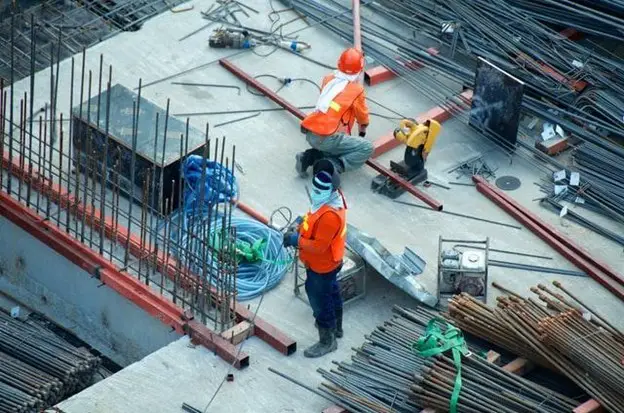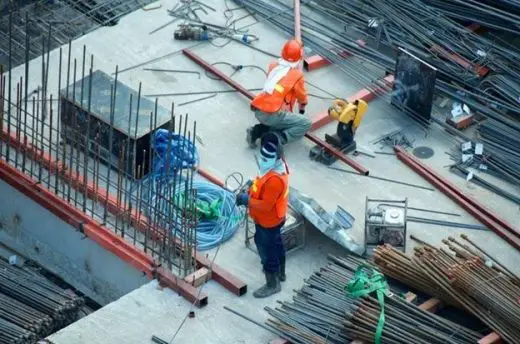Common Types of Accidents on Construction Sites in UK guide, Building Site Safety Tips, Online H&S Advice
Common Types of Accidents on Construction Sites in the UK
24 Jan 2022
Common Types of Accidents Occurring on Construction Sites in the UK
According to the Health and Safety Executive (HSE), there were 39 fatal injuries to workers in 2020/21. 61,000 working people sustained a non-fatal injury over a three-year period – 2018/19-2020/21. Due to the nature of the work that must be completed, the construction industry is essentially dangerous.
There are a number of injuries that can occur on the job. In spite of the fact that people are trained to avoid and be cautious when it comes to certain tasks, there’s still the possibility of something bad happening. In these circumstances, the construction company, contractor, or subcontractor may be responsible for the injuries.
In what follows, we’ll take a look at the top injuries at a construction site.
Tripping Hazards
Workers in the construction industry are exposed to tripping hazards. A trip takes place when the foot strikes or collides with something, after which you lose balance. The ground surface, floors, and other building surfaces tend to be uneven, slippery, and sloping. High-risk areas need to be identified and dealt with to prevent unfortunate incidents.
Construction sites are cluttered with building materials, power tools, and materials. Let’s not forget about the cables and wiring, which are used to deliver power, control, data, security, and so on, to the infrastructure. It’s crucial to trail wires and cables to prevent trip hazards and to protect people from an electrical shock. It’s important to understand that there’s no quick fix.
A clean and orderly site must be maintained to reduce the likelihood of people being injured and making a personal injury claim. As pointed out by the experts at Accident Claims Advice, the injury burden is, more often than not unrecognized. Reducing trips requires a focus on environmental and organisational solutions, as the site changes and the project moves forward.
Many accidents can be mitigated through engineering controls, including adequate lighting, slip-resistant flooring and mats, and the installation of ramps and handrails. Work practice controls can reduce the duration, frequency, severity, and exposure to tripping situations. These include measures like carrying out health and safety inspections, reviewing incidents, and correcting poor work practices.
Defective Equipment
Defective equipment is any equipment that’s unsafe or presents manufacturing defects. The types of equipment that are most likely to cause injury to construction workers are:
- Forklifts – Forklifts are used to move materials like bricks and wood across sites and distances. Regrettably, forklifts are prone to accidents. Dangers include falling out and getting crushed by a tipping forklift, falling from a platform detached from a forklift, and being struck by a material falling from an open cab.
- Cranes – Cranes are material movement machinery used to relocate what can’t be moved by smaller machinery or human power. Crane accidents are some of the most common mishaps. Examples include dropped loads, crane contact with power lines, and crushing by the counterweight.
- Scaffolding – Temporary scaffolding is needed during the maintenance of any structure, tower, or monument. Defective scaffolding can lead to falls, causing head injuries, spinal damage, and fractures. Depending on the nature of the accident, injuries can be moderate or severe.
Exposure To Excessive Noise and Vibrating Tools
A construction site is a noisy place to work. Tumultuous activities include dump trucks, jackhammers, cement mixers, electric saws, and welding machines, to name a few. Noise can be generated by hand-held vibrating tools, of which mention can be made of power drills polishers, road breakers, and grinders. The use of such power tools affects countless industrial workers. It leads to damage to the blood vessels, nerves, muscles, and joints of the wrist.
It’s the responsibility of the employer to check for excessive noise and, if possible, to reduce the level of noise of the period of time workers are exposed to the noise. Controlling noise at construction sites can be accomplished by selecting low-noise machinery, maintaining and lubricating equipment, and placing barriers between the workers and noise.
Excessive noise can lead to loss of hearing, harm animals and aquatic life, and have negative effects on the well-being of individuals. The higher the noise level, the more drastic the consequences. Given that the adverse effects have a very important influence on people’s health and well-being, it’s crucial to evaluate noise exposure and propose preventative solutions.
Construction Vehicle Accidents
Construction vehicles can be dangerous, deadly even. Dump trucks are the most menacing type of vehicle, as they’re the leading cause of struck-by injuries. Workers involved in accidents have suffered broken bones, chemical burns, crushing injuries, or limbs lost. When vehicles and passers-by come into contact, the results are disastrous. This is precisely why it’s necessary to provide walkways for pedestrian use, barriers, crossings entrances/ exits.
When hiring is done, only people that are knowledgeable and trained should be selected. Workers should be properly educated prior to operating a vehicle on a construction site. Also, maintenance should be carried out to ensure that vehicles don’t break down unexpectedly or behave erratically.
Anyone can be hurt at a construction site. This means that besides workers, contractors, self-employed professionals, and members of the public can be harmed. It’s necessary to evaluate the risk for each hazard and calculate the likelihood that it can cause harm. Injuries to any party can occur, which would lead to conflict. The fault is on the part of the employer. It’s imperative to pay for the injuries regardless of who is at fault.
Electric Shock
More often than not, construction workers are at risk of electric shock. Exposure to electrical energy might result in no injury or devastating damage. At construction sites, there are lots of pieces of equipment that, if used incorrectly, can result in injuries like burns, scarring, long-term nerve damage, or death. Before starting work – demolition, excavation, etc. – the employer must determine the voltage levels of electrical lines and installations around or near the site.
Incidents are caused by direct or indirect contact with live electrical equipment and wiring, including light fixtures, control panels, circuit breakers, transformers, and so forth. Workers should exercise caution near energized lines and use appropriate personal protective equipment. Most importantly, metal objects should be kept away from live electrical circuits or parts.
Comments on this guide to Common Types of Accidents on Construction Sites in UK article are welcome.
Construction Articles
Construction Posts
Building a Pedestrian Bridge Construction
Make Your Construction Fleet Efficient
5 reasons to use steel in residential construction
Ways to deal with Construction Waste
Building Articles
Residential Architecture
Comments / photos for the Common types of accidents on construction sites in UK page welcome






